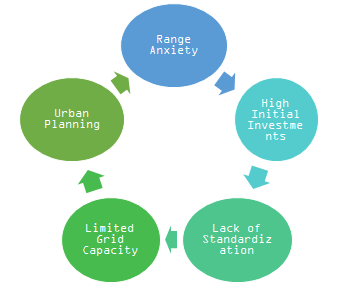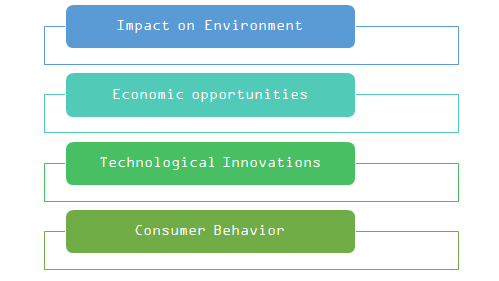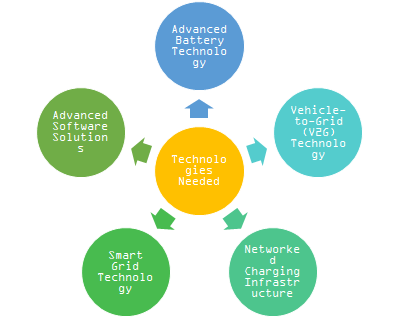Energy Transition – Challenges, Opportunities, and Technology Needed to Facilitate Rapid Transportation Electrification
Written by Suresh Velamuri, Akhilesh Prakash Gupta, and Pranavamoorthy Balasubramanian
The traditional power grid was designed for unidirectional power flow, assuming controlled fossil-fuel-based sources and inelastic demand. However, the energy transition, particularly with the adoption of electric vehicles (EVs), has caused significant changes in power system planning and operation. EVs can overload the grid and cause localized power outages, particularly if the charging infrastructure is not properly designed or managed. Power systems must adapt to bidirectional power flows, low inertia grids, price-responsive demands, and changing human behavior.
This article focuses on the challenges of the energy transition and potential solutions, with a primary focus on EVs, charging infrastructure, and their impact on the grid. To tackle these challenges, planning tools must be developed for distribution expansion planning in the presence of high renewables, advanced grid monitoring, fast controls, managed charging, and policies to incentivize the adoption of distributed energy resources and grid support. Solutions like enhanced customer experience and engaging EV users are anticipated at the customer level. At the EV charging infrastructure level, cost-effective alternatives to expensive grid expansion plans, such as dynamic load balancing, local peak shaving limits, and incorporating storage devices are recommended. At the grid level, utilities must collaborate with EV charging stations and other distributed energy resources to optimally plan EV charging infrastructure capacity and location in low-voltage and medium-voltage distribution networks.
Introduction
The increasing prevalence of electric vehicles (EVs) in the energy transition has necessitated significant changes in power system planning and operation. EVs can pose a challenge to the power grid, as they have the potential to overload the grid and lead to localized power outages if the charging infrastructure is not correctly designed or managed. To meet the needs of the energy transition, power systems must now be able to handle the reverse flow of power from distributed generation and renewable energy sources, such as solar panels and wind turbines. The power grid must be reconfigured to cope with the challenges posed by EVs, as the growth of renewable energy sources and the trend towards more dynamic pricing models exacerbate the complexities of managing the grid. The transition towards a smarter, more adaptable, and resilient grid is vital to ensuring that energy is distributed in a manner that is both sustainable and equitable for all users.
Challenges in Transition to EVs
Figure 1. Major challenges to the energy transition due to the growing number of EVs and charging infrastructure.
- Range Anxiety: Range anxiety is the fear of running out of charge and being stranded. To alleviate this anxiety, the charging infrastructure must be widely available and easily accessible.
- High Initial Investments: The cost of installing fast charging infrastructure can be high, which presents a challenge for public charging infrastructure development, as well as for businesses and individuals who want to install charging stations on their sites [1].
- Lack of Standardization: This is a major barrier to the widespread adoption of EVs. In the present market, there are many types of charging connectors, communication protocols, and charging rates followed by manufacturers and charging service providers. Hence compatibility issues arise for both EV users and EVCI service providers. For wider adoption of EVs standardization is much needed.
- Limited Grid Capacity: Increased penetration of EVs can cause strain on the electricity grid and result in power outages & increased electricity costs. Hence there is a need for a coordinated effort to upgrade the grid and ensure that it can support the additional electricity demand.
- Urban Planning: The location, sizing, and design of charging infrastructure must be carefully planned to ensure that it is easily accessible for drivers and fits within the existing urban infrastructure. This could include considerations such as existing petrol stations and commercial buildings.
Opportunities with Transportation Electrification
- Impact on the Environment: There is a huge potential for minimizing greenhouse gas emissions through a transition to EVs. This in turn helps in improving the quality of air and public health [2].
- Economic Opportunities: Transforming to EV usage will lead to the growth of the EV industry, thereby EVCI development. In the future, used EV batteries may not meet the desired specification requirements to be used in EVs. This turns out to be an opportunity in utilizing the second life of those batteries in other suitable applications. The cost of storage systems will reduce abruptly with these second-life batteries [3]. This provides many economic opportunities in terms of jobs in many fields like charging stations, manufacturing, etc.
- Technological Innovations: There is a huge potential for progression in technologies such as smart grids, energy management, Distributed Energy Resource Management systems, and Battery Management systems with the rapid developments in EVCI.
- Consumer Behavior: Consumer behaviors tend to shift towards sustainable modes of transportation with the right economic incentives and user-utility interactive energy management systems. This trend can lead to a rapid transition towards EVs and EVCI soon globally.
Figure 2. Opportunities associated with the modern grid's high EV adoption rate.
Technology Needed to Facilitate Rapid Transportation Electrification
- Advanced Battery Technology: For the faster adoption rate of EVs, improvements in battery designs are very important. The batteries should possess high energy density and be capable of fast charging. This allows EV users to rethink on time taken for charging as a barrier.
- Vehicle to Grid (V2G) Technology: Using this technology EV users can feedback power to the grid during the hours of non-EV usage. This approach will help in reducing the peak demand and improve the stability of the grid. EV owners also get revenue while selling excess power to the grid [4].
- Networked Charging Infrastructure: The charging infrastructure should be networked and should be capable of providing fast charging. Planning the public EVCI stations wisely at optimal locations and capacities helps in the faster adoption of EVs.
- Smart Grid Technology: Advanced Smart grid infrastructure is needed to manage the integration of EVs. Integration of DERs and managing the charging demand from EVs is possible with this infrastructure. With advanced metering infrastructure and communication, demand response programs can be facilitated. These methods adopt an incentive-based approach to the customers for minimizing electricity consumption, thereby improving grid stability and utilization of peak power plants [5].
- Advanced Software Solutions: Deploying software solutions and utilizing them for managing, and optimizing charge/discharge schedules, GPS-based fleet management, and Real-time information through mobile apps can aid in the efficient usage of EV fleets.
Figure 3. Required technologies to enable rapid transportation electrification.
Conclusion
During this energy transition, especially with increasing EV adoption, power systems must accommodate bidirectional power flows, EV charging infrastructure, low-inertia grids, high renewables, price-responsive needs, and changing human behaviors. EVs will have influence over the electrical grid in the future due to their ability to absorb and inject electricity into smart grids. This article presented the energy transition challenges and solutions, focusing on EVs and charging infrastructure. To address these issues, various solutions must be developed at various levels, including planning/policy formulation, grid level, EV charging infrastructure level, and customer level. Dynamic load balancing, local peak shaving limitations, and storage devices are some of the cost-effective solutions. Utilities must interact with EV charging stations and other distributed energy resources to optimize low-voltage and medium-voltage distribution network EV charging infrastructure capacity and location.
References
- A. Nath, Z. Rather, I. Mitra, and S. L., "Multi-criteria Approach for Identification and Ranking of Key Interventions for Seamless Adoption of Electric Vehicle Charging Infrastructure," in IEEE Transactions on Vehicular Technology, DOI: 10.1109/TVT.2023.3252273.
- R. Faria, P. Moura, J. Delgado, and A. T. de Almeida, "Managing the Charging of Electrical Vehicles: Impacts on the Electrical Grid and on the Environment," in IEEE Intelligent Transportation Systems Magazine, vol. 6, no. 3, pp. 54-65, Fall 2014, DOI: 10.1109/MITS.2014.2323437.
- Engel, H., P. Hertzke, and G. Siccardo. "Electric vehicles, second life batteries, and their effect on the power sector| McKinsey. 2019."
- A. Ghazanfari and C. Perreault, "The Path to a Vehicle-to-Grid Future: Powering Electric Mobility Forward," in IEEE Industrial Electronics Magazine, vol. 16, no. 3, pp. 4-13, Sept. 2022, DOI: 10.1109/MIE.2021.3072602.
- N. Erdogan, S. Kucuksari and U. Cali, "Co-Simulation of Optimal EVSE and Techno-Economic System Design Models for Electrified Fleets," in IEEE Access, vol. 10, pp. 18988-18997, 2022, DOI: 10.1109/ACCESS.2022.3150359.
This article was edited by Vigna Kumaran.
To view all articles in this issue, please go to June 2023 eNewsletter. For a downloadable copy, please visit the IEEE Smart Cities Resource Center.



To have the Bulletin delivered monthly to your inbox, join the IEEE Smart Grid Community.
Past Issues
To view archived articles, and issues, which deliver rich insight into the forces shaping the future of the smart grid. Older Bulletins (formerly eNewsletter) can be found here. To download full issues, visit the publications section of the IEEE Smart Grid Resource Center.







